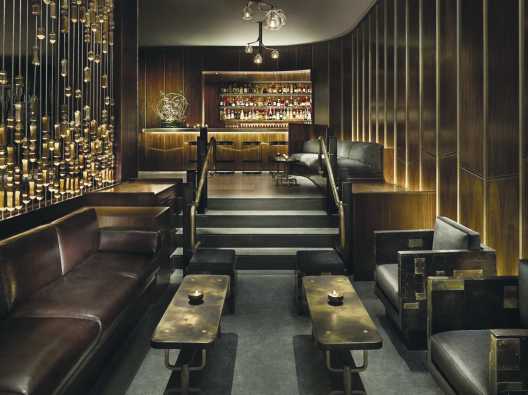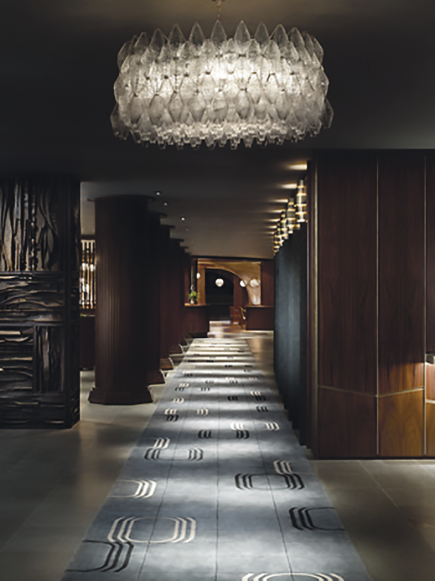- Home
- Media Kit
- Current Issue
- Past Issues
- Ad Specs-Submission
- Ad Print Settings
- Reprints (PDF)
- Photo Specifications (PDF)
- Contact Us

![]()
ONLINE

Iconic Design
Editors’ Note
Prior to his current post, Bryan Woody was Hotel Manager for Hudson of Morgans Hotel Group in New York. Before this, he was Assistant Director of Food & Beverage at Waldorf Astoria Hotel, as well as at The Ritz-Carlton New York, Central Park. He was also Private Dining and In-Room Dining Manager with the Gordon Ramsay Group. Woody graduated from the University of Utah with a Bachelor of Science in Economics.
Property Brief
The iconic Royalton (morganshotelgroup.com) has been brilliantly reinvented by Roman and Williams, reinstating its place as the stylish living room of Manhattan, and a crossroads for international travelers and the New York elite. Simultaneously sophisticated and complex, this New York midtown luxury boutique hotel features a floor-to-ceiling, hand-forged cast bronze fireplace, a 20-foot screen that was once part of the façade of a building in France, and hand-upholstered leather walls reminiscent of African tribal art. Royalton’s popular Forty Four bar and restaurant remains the gathering place and power lunch spot for New York City’s media, publishing, and fashion elite. Located in the heart of midtown, the Royalton is just steps from great shopping, Broadway, the Theater District, Grand Central Station, Empire State Building, Times Square, Bryant Park, and Rockefeller Center.
What excited you about coming to Morgans Hotel Group and has the role been what you expected?
The potential to shift my focus to lifestyle hotels was what enticed me to come to Morgans. I have always worked in luxury or in an old-world luxury setting, and an opportunity to come in with a group like this fit my personal taste better.
I tend to gravitate towards things that are a bit more cutting-edge and that is the direction the industry is going.

The Royalton bar
Are there certain characteristics that define a Morgans property or is it specific to the immediate location?
There are many qualities that make it distinctly Morgans: iconic design is one. It gives you an immediate sense of feel and place that sets it apart from the rest of its competitors. When you step into a building like the Royalton designed by Philippe Starck, it’s very distinguishing.
Would you talk about the room mix at the Royalton and is there a common feel throughout the property?
The rooms here are much larger in footprint than Hudson – we’re getting much better square footage, and most of them have large bathtubs in them and functional fireplaces. It caters geographically to a business traveler. However, some of our guests are looking for something more spacious and they’re coming out for leisure; we’re right next to Bryant Park and off of Times Square but not within the madness; in the center of midtown Manhattan, there is something for just about everybody.

The Royalton living room
Have you found a way to be profitable in the food and beverage part of the business and, for Morgans, how important is it that the properties offer that component?
It’s more important than ever for us to be able to compete in that arena. Being at Hudson three years ago, when we looked up and down 59th Street, nobody was succeeding. We did significant reinvention of the food and beverage at that property and it has been tremendously successful. Through creative repositioning around what a customer wants and diversifying each of the offerings, we have been able to turn a profit in the food and beverage outlets.
In the lifestyle segment, how much of a focus does the spa need to be?
I don’t think the spa product is necessary, at least in the New York market. If you have a 24-hour/seven-day-a-week fitness center that ticks all the boxes, that is what people are looking for. We’re fortunate enough to have locations close to Bryant Park and adjacent to Central Park that offer outside options. For the rare occasion where someone needs something more, we have some strategic partnerships where we work with full-service fitness centers and spas where our guests can utilize their services.

The Royalton lobby
How far have you taken the technology and how do you ensure that you don’t lose that personal touch?
We always want to stay ahead of the curve with the technology, and make sure that we’re focused on a social media side and engaging them in that manner.
Other competitors have put in fully automated systems and removed that human element altogether, but that puts you at risk of eliminating the hospitality element. It’s a very fine line and we’re going to err on the side of exceptional customer service.
Have the rates come back and where do we stand on those today?
We’re seeing them come back slowly. We haven’t seen them hit that tipping point of the 2007 levels but New York is always going to drive that occupancy. It’s just the rate and that seems to be the challenge.
A bit more time and patience and a bit less incremental inventory in 2015 would help a lot.
At some point, will you worry about the oversupply in New York?
The New York market will always drive additional visitors and there will always be new supply. This past year was a benchmark year, and with Superbowl faltering as much as it did, it’s worrisome to some. However, as long as we can get better regulation and enforcement of competitors like Airbnb, it’s something that will be manageable. New York will remain an 85 to 95 occupancy percent market regardless of the inventory; it’s just a question of ADR. Regardless, we will continue to compete well in it.•